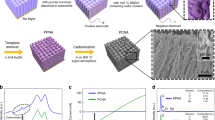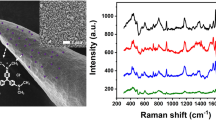Abstract
Nanofibers functionalized by metal nanostructures and particles are exploited as effective flexible substrates for surface-enhanced Raman scattering (SERS) analysis. Their complex three-dimensional structure may provide Raman signals enhanced by orders of magnitude compared to untextured surfaces. Understanding the origin of such improved performances is therefore very important for pushing nanofiber-based analytical technologies to their upper limit. Here, we report on polymer nanofiber mats which can be exploited as substrates for enhancing the Raman spectra of adsorbed probe molecules. The increased surface area and the scattering of light in the nanofibrous system are individually analyzed as mechanisms to enhance Raman scattering. The deposition of gold nanorods on the fibers further amplifies Raman signals due to SERS. This study suggests that Raman signals can be finely tuned in intensity and effectively enhanced in nanofiber mats and arrays by properly tailoring the architecture, composition, and light-scattering properties of the complex networks of filaments.

Enhancement of Raman signals by electrospun nanofiber mats





Similar content being viewed by others
References
McDonagh C, Burke CS, MacCraith BD. Optical chemical sensors. Chem Rev. 2008;108:400–22.
Homola J. Surface plasmon resonance sensors for detection of chemical and biological species. Chem Rev. 2008;108:462–93.
Novotny L, Van Hulst N. Antennas for light. Nat Photonics. 2011;5:83–90.
Baaske MD, Foreman MR, Vollmer F. Single-molecule nucleic acid interactions monitored on a label-free microcavity biosensor platform. Nat Nanotechnol. 2014;9:933–9.
Kneipp K, Moskovits M, Kneipp H. Surface enhanced raman scattering. New York: Springer; 2006.
Armani AM, Kulkarni RP, Fraser SE, Flagan RC, Vahala KJ. Label-free, single-molecule detection with optical microcavities. Science. 2007;317:783–7.
Özdemira SK, Zhu J, Yang X, Peng B, Yilmaz H, He L, et al. Highly sensitive detection of nanoparticles with a self-referenced and self heterodyned whispering-gallery Raman microlaser. Proc Natl Acad Sci U S A. 2014;111:E3836–44.
Sun Y, Fan X. Optical ring resonators for biochemical and chemical sensing. Anal Bioanal Chem. 2011;399:205–11.
Sharma AC, Jana T, Kesavamoorthy R, Shi L, Virji MA, Finegold DN, et al. A general photonic crystal sensing motif: creatinine in bodily fluids. J Am Chem Soc. 2004;126:2971–7.
Baker JE, Sriram R, Miller BL. Two-dimensional photonic crystals for sensitive microscale chemical and biochemical sensing. Lab Chip. 2015;15:971–90.
Fujiwara M, Toubaru K, Noda T, Zhao H-Q, Takeuchi S. Highly efficient coupling of photons from nanoemitters into single-mode optical fibers. Nano Lett. 2011;11:4362–5.
Stockman M. Nanofocusing of optical energy in tapered plasmonic waveguides. Phys Rev Lett. 2004;93:137404.
Yang X, Zhang AY, Wheeler DA, Bond TC, Gu C, Li Y. Direct molecule-specific glucose detection by Raman spectroscopy based on photonic crystal fiber. Anal Bioanal Chem. 2012;402:687–91.
Zijlstra P, Paulo PMR, Orrit M. Optical detection of single non-absorbing molecules using the surface plasmon resonance of a gold nanorod. Nat Nanotechnol. 2012;7:379–82.
Aizpurua J, Bryant GW, Richter LJ, Garcia de Abajo FJ. Optical properties of coupled metallic nanorods for field-enhanced spectroscopy. Phys Rev B. 2005;71:235420.
Halas NJ, Lal S, Chang W-S, Link S, Nordlander P. Plasmons in strongly coupled metallic nanostructures. Chem Rev. 2011;111:3913–61.
Min B, Ostby E, Sorger V, Ulin-Avila E, Yang L, Zhang X, et al. High-Q surface-plasmon-polariton whispering-gallery microcavity. Nature. 2009;457:455–8.
Lerma Arce C, Witters D, Puers R, Lammertyn J, Bienstman P. Silicon photonic sensors incorporated in a digital microfluidic system. Anal Bioanal Chem. 2012;404:2887–94.
De Angelis F, Gentile F, Mecarini F, Das G, Moretti M, Candeloro P, et al. Breaking the diffusion limit with super-hydrophobic delivery of molecules to plasmonic nanofocusing SERS structures. Nat Photonics. 2011;5:682–7.
Colthup N. Introduction to infrared and Raman spectroscopy. Elsevier; 2012.
Eesley GL. Coherent Raman Spectroscopy. Elsevier; 2013.
Ferrari AC, Basko DM. Raman spectroscopy as a versatile tool for studying the properties of graphene. Nat Nanotechnol. 2013;8:235–46.
Guieu V, Lagugné‐Labarthet F, Servant L, Talaga D, Sojic N. Ultrasharp optical‐fiber nanoprobe array for raman local‐enhancement imaging. Small. 2008;4:96–9.
De Luca AC, Rusciano G, Ciancia R, Martinelli V, Pesce G, Rotoli B, et al. Spectroscopical and mechanical characterization of normal and thalassemic red blood cells by Raman tweezers. Opt Express. 2008;16:7943–57.
Maier SA. Plasmonics: fundamentals and applications. Springer; 2007.
Fan M, Andrade GF, Brolo AG. A review on the fabrication of substrates for surface enhanced Raman spectroscopy and their applications in analytical chemistry. Anal Chim Acta. 2011;693:7–25.
Moskovits M. Surface‐enhanced Raman spectroscopy: a brief retrospective. J Raman Spectrosc. 2005;36:485–96.
Harpster MH, Zhang H, Sankara-Warrier AK, Ray BH, Ward TR, Kollmar JP, et al. SERS detection of indirect viral DNA capture using colloidal gold and methylene blue as a Raman label. Biosens Bioelectron. 2009;25:674–81.
Xiao GN, Man SQ. Surface-enhanced Raman scattering of methylene blue adsorbed on cap-shaped silver nanoparticles. Chem Phys Lett. 2007;447:305–9.
D’Andrea C, Bochterle J, Toma A, Huck C, Neubrech F, Messina E, et al. Optical nanoantennas for multiband surface-enhanced infrared and Raman spectroscopy. ACS Nano. 2013;7:3522–31.
Foti A, D’Andrea C, Bonaccorso F, Lanza M, Calogero G, Messina E, et al. A shape-engineered surface-enhanced raman scattering optical fiber sensor working from the visible to the near-infrared. Plasmonics. 2013;8:13–23.
Zeman EJ, Schatz GC. An accurate electromagnetic theory study of surface enhancement factors for silver, gold, copper, lithium, sodium, aluminum, gallium, indium, zinc, and cadmium. J Phys Chem. 1987;91:634–43.
Maher RC. SERS hot spots. Raman spectroscopy for nanomaterials characterization 215–260. Berlin: Springer; 2012.
Polavarapu L, Pérez-Juste J, Xu QH, Liz-Marzán LM. Optical sensing of biological, chemical and ionic species through aggregation of plasmonic nanoparticles. J Mater Chem C. 2014;2:7460–76.
Wu DY, Li JF, Ren B, Tian ZQ. Electrochemical surface-enhanced Raman spectroscopy of nanostructures. Chem Soc Rev. 2008;37:1025–41.
Vo-Dinh T. SERS chemical sensors and biosensors: new tools for environmental and biological analysis. Sensors Actuat B Chem. 1995;29:183–9.
Boyd S, Bertino MF, Ye D, White LS, Seashols SJ. Highly sensitive detection of blood by surface enhanced Raman scattering. J Forensic Sci. 2013;58:753–6.
Anker JN, Hall WP, Lyandres O, Shah NC, Zhao J, Van Duyne RP. Biosensing with plasmonic nanosensors. Nat Mater. 2008;7:442–53.
Scaffidi JP, Gregas MK, Seewaldt V, Vo-Dinh T. SERS-based plasmonic nanobiosensing in single living cells. Anal Bioanal Chem. 2009;393:1135–41.
Ahmed A, Gordon R. Single molecule directivity enhanced Raman scattering using nanoantennas. Nano Lett. 2012;12:2625–30.
Hatab NA, Hsueh C-H, Gaddis AL, Retterer ST, Li J-H, Eres G, et al. Free-standing optical gold bowtie nanoantenna with variable gap size for enhanced Raman spectroscopy. Nano Lett. 2010;10:4952–5.
Banholzer MJ, Millstone JE, Qin L, Mirkin CA. Rationally designed nanostructures for surface-enhanced Raman spectroscopy. Chem Soc Rev. 2008;37:885–97.
Sun J, Xianyu Y, Jiang X. Point-of-care biochemical assays using gold nanoparticle-implemented microfluidics. Chem Soc Rev. 2014;43:6239–53.
He D, Hu B, Yao Q-F, Wang K, Yu S-H. Large-scale synthesis of flexible free-standing SERS substrates with high sensitivity: electrospun PVA nanofibers embedded with controlled alignment of silver nanoparticles. ACS Nano. 2009;3:3993–4002.
Shao J, Tong L, Tang S, Guo Z, Zhang H, Li P, et al. PLLA nanofibrous paper-based plasmonic substrate with tailored hydrophilicity for focusing SERS detection. ACS Appl Mater Interfaces. 2015;7:5391–9.
Persano L, Camposeo A, Pisignano D. Active polymer nanofibers for photonics, electronics, energy generation and micromechanics. Prog Polym Sci. 2015;43:48–95.
Camposeo A, Persano L, Pisignano D. Light-emitting electrospun nanofibers for nanophotonics and optoelectronics. Macromol Mater Eng. 2013;298:487–503.
Persano L, Camposeo A, Tekmen C, Pisignano D. Industrial upscaling of electrospinning and applications of polymer nanofibers: a review. Macromol Mater Eng. 2013;298:504–20.
Fang J, Niu H, Wang H, Wang X, Lin T. Enhanced mechanical energy harvesting using needleless electrospun poly(vinylidene fluoride) nanofibre webs. Energy Environ Sci. 2013;6:2196–202.
Pisignano D. Polymer nanofibers, Royal Society of Chemistry. 2013.
Zhang C-L, Lv K-P, Cong H-P, Yu S-H. Controlled assemblies of gold nanorods in PVA nanofiber matrix as flexible free-standing SERS substrates by electrospinning. Small. 2012;8:648–53.
Yang T, Yang H, Zhen SJ, Huang CZ. Hydrogen-bond-mediated in situ fabrication of AgNPs/Agar/PAN electrospun nanofibers as reproducible SERS substrates. ACS Appl Mater Interfaces. 2015;7:1586–94.
Lee CH, Tian L, Abbas A, Kattumenu R, Singamaneni S. Directed assembly of gold nanorods using aligned electrospun polymer nanofibers for highly efficient SERS substrates. Nanotechnology. 2011;22:275311.
Zhao Y, Sun L, Xi M, Feng Q, Jiang C, Fong H. Electrospun TiO2 nanofelt surface-decorated with Ag nanoparticles as sensitive and UV-cleanable substrate for surface enhanced Raman scattering. ACS Appl Mater Interfaces. 2014;6:5759–67.
Qian Y, Meng G, Huang Q, Zhu C, Huang Z, Suna K, et al. Flexible membranes of Ag-nanosheet-grafted polyamide-nanofibers as effective 3D SERS substrates. Nanoscale. 2014;6:4781–8.
Yang H, Huang CZ. Polymethacrylic acid–facilitated nanofiber matrix loading Ag nanoparticles for SERS measurements. RSC Adv. 2014;4:38783–90.
Marega C, Maculan J, Rizzi GA, Saini R, Cavaliere E, Gavioli L, et al. Polyvinyl alcohol electrospun nanofibers containing Ag nanoparticles used as sensors for the detection of biogenic amines. Nanotechnology. 2015;26:075501.
Szymborski T, Witkowska E, Adamkiewicz W, Waluk J, Kamińska A. Electrospun polymer mat as a SERS platform for the immobilization and detection of bacteria from fluids. Analyst. 2014;139:5061–4.
Gao W, Chen G, Xu W, Yang C, Xu S. Surface-enhanced Raman scattering (SERS) chips made from metal nanoparticle-doped polymer fibers. RSC Adv. 2014;4:23838–45.
Vigderman L, Khanal BP, Zubarev ER. Functional gold nanorods: synthesis, self‐assembly, and sensing applications. Adv Mater. 2012;24:4811–41.
Indrasekara ASDS, Wadams RC, Fabris L. Ligand exchange on gold nanorods: going back to the future. Part Part Syst Charact. 2014;31:819–38.
Thompson CJ, Chase GG, Yarin AL, Reneker DH. Effects of parameters on nanofiber diameter determined from electrospinning model. Polymer. 2007;48:6913e6922.
Fridrikh SV, Yu JH, Brenner MP, Rutledge GC. Controlling the fiber diameter during electrospinning. Phys Rev Lett. 2003;90:144502.
Lauricella M, Pontrelli G, Coluzza I, Pisignano D, Succi S. Different regimes of the uniaxial elongation of electrically charged viscoelastic jets due to dissipative air drag. Mech Res Commun. 2015;69:97–102.
Hou H, Jun Z, Reuning A, Schaper A, Wendorff JH, Greiner A. Poly(p-xylylene) nanotubes by coating and removal of ultrathin polymer template fibers. Macromolecules. 2002;35:2429–31.
Wang X, Drew C, Lee S-H, Senecal KJ, Kumar J, Samuelson LA. Electrospun nanofibrous membranes for highly sensitive optical sensors. Nano Lett. 2002;2:1273–5.
Willis HA, Zichy VJI, Hendra PJ. The laser-Raman and infra-red spectra of poly (methyl methacrylate). Polymer. 1969;10:737–46.
Thomas KJ, Sheeba M, Nampoori VPN, Vallabhan CPG, Radhakrishnan P. Raman spectra of polymethylmethacrylate optical fibres excited by a 532 nm diode pumped solid state laser. J Opt A Pure Appl Opt. 2008;10:055303.
Bohren CF, Huffman DR. Absorption and scattering of light by small particles. Weinheim: Wiley-VCH Verlag; 2004.
Wiersma DS. Disordered photonics. Nat Photonics. 2013;7:188–96.
Kim I-D, Rothschild A, Lee BH, Kim DY, Jo SM, Tuller HL. Ultrasensitive chemiresistors based on electrospun TiO2 nanofibers. Nano Lett. 2006;6:2009–13.
D’Andrea C, Fazio B, Gucciardi PG, Giordano MC, Martella C, Chiappe D, et al. SERS enhancement and field confinement in nanosensors based on self-organized gold nanowires produced by ion-beam sputtering. J Phys Chem C. 2014;118:8571–80.
Kessentini S, Barchiesi D, D’Andrea C, Toma A, Guillot N, Di Fabrizio E, et al. Gold dimer nanoantenna with slanted gap for tunable LSPR and improved SERS. J Phys Chem C. 2014;118:3209–19.
Acknowledgments
We thank A. Foti, B. Fazio, and M. G. Donato for fruitful discussions. We acknowledge the Italian Ministry of Education, University and Research (MIUR), “Programma Operativo Nazionale Ricerca e Competitività” 2007–2013 e “Piano di Azione e Coesione”, project PAC02L3_00087 “SOCIAL-NANO.” A.C., M.M., L.P., and D.P. also thank the support from the European Research Council under the European Union’s Seventh Framework Programme (FP/2007–2013)/ERC Grant Agreement n. 306357 (“NANO-JETS”). The Apulia Networks of Public Research Laboratories Wafitech (09) and M. I. T. T. (13) are also acknowledged.
Author information
Authors and Affiliations
Corresponding authors
Ethics declarations
Conflict of interest
The authors declare no competing financial interest. Andrea Camposeo and Luana Persano are the founders of Soft Materials and Technologies SRL.
Additional information
Published in the topical collection Fiber-based Platforms for Bioanalytics with guest editors Antje J. Baeumner and R. Kenneth Marcus.
Electronic supplementary material
Below is the link to the electronic supplementary material.
ESM 1
(PDF 642 kb)
Rights and permissions
About this article
Cite this article
Camposeo, A., Spadaro, D., Magrì, D. et al. Surface-enhanced Raman spectroscopy in 3D electrospun nanofiber mats coated with gold nanorods. Anal Bioanal Chem 408, 1357–1364 (2016). https://doi.org/10.1007/s00216-015-9226-9
Received:
Revised:
Accepted:
Published:
Issue Date:
DOI: https://doi.org/10.1007/s00216-015-9226-9




